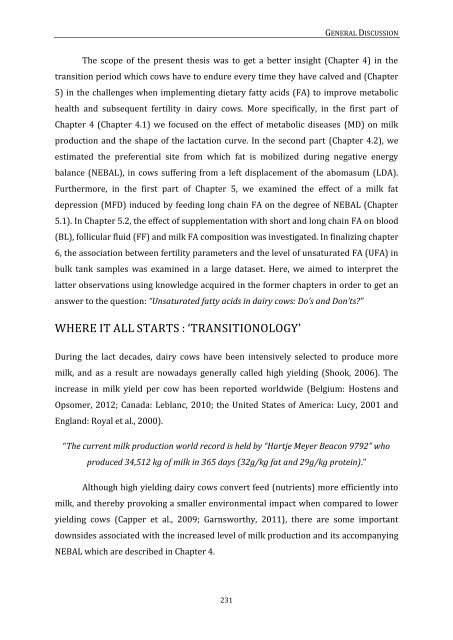view - Department of Reproduction, Obstetrics and Herd Health
view - Department of Reproduction, Obstetrics and Herd Health
view - Department of Reproduction, Obstetrics and Herd Health
Create successful ePaper yourself
Turn your PDF publications into a flip-book with our unique Google optimized e-Paper software.
GENERAL DISCUSSION<br />
The scope <strong>of</strong> the present thesis was to get a better insight (Chapter 4) in the<br />
transition period which cows have to endure every time they have calved <strong>and</strong> (Chapter<br />
5) in the challenges when implementing dietary fatty acids (FA) to improve metabolic<br />
health <strong>and</strong> subsequent fertility in dairy cows. More specifically, in the first part <strong>of</strong><br />
Chapter 4 (Chapter 4.1) we focused on the effect <strong>of</strong> metabolic diseases (MD) on milk<br />
production <strong>and</strong> the shape <strong>of</strong> the lactation curve. In the second part (Chapter 4.2), we<br />
estimated the preferential site from which fat is mobilized during negative energy<br />
balance (NEBAL), in cows suffering from a left displacement <strong>of</strong> the abomasum (LDA).<br />
Furthermore, in the first part <strong>of</strong> Chapter 5, we examined the effect <strong>of</strong> a milk fat<br />
depression (MFD) induced by feeding long chain FA on the degree <strong>of</strong> NEBAL (Chapter<br />
5.1). In Chapter 5.2, the effect <strong>of</strong> supplementation with short <strong>and</strong> long chain FA on blood<br />
(BL), follicular fluid (FF) <strong>and</strong> milk FA composition was investigated. In finalizing chapter<br />
6, the association between fertility parameters <strong>and</strong> the level <strong>of</strong> unsaturated FA (UFA) in<br />
bulk tank samples was examined in a large dataset. Here, we aimed to interpret the<br />
latter observations using knowledge acquired in the former chapters in order to get an<br />
answer to the question: “Unsaturated fatty acids in dairy cows: Do’s <strong>and</strong> Don’ts”<br />
WHERE IT ALL STARTS : ‘TRANSITIONOLOGY’<br />
During the lact decades, dairy cows have been intensively selected to produce more<br />
milk, <strong>and</strong> as a result are nowadays generally called high yielding (Shook, 2006). The<br />
increase in milk yield per cow has been reported worldwide (Belgium: Hostens <strong>and</strong><br />
Opsomer, 2012; Canada: Leblanc, 2010; the United States <strong>of</strong> America: Lucy, 2001 <strong>and</strong><br />
Engl<strong>and</strong>: Royal et al., 2000).<br />
“The current milk production world record is held by “Hartje Meyer Beacon 9792” who<br />
produced 34,512 kg <strong>of</strong> milk in 365 days (32g/kg fat <strong>and</strong> 29g/kg protein).”<br />
Although high yielding dairy cows convert feed (nutrients) more efficiently into<br />
milk, <strong>and</strong> thereby provoking a smaller environmental impact when compared to lower<br />
yielding cows (Capper et al., 2009; Garnsworthy, 2011), there are some important<br />
downsides associated with the increased level <strong>of</strong> milk production <strong>and</strong> its accompanying<br />
NEBAL which are described in Chapter 4.<br />
231









